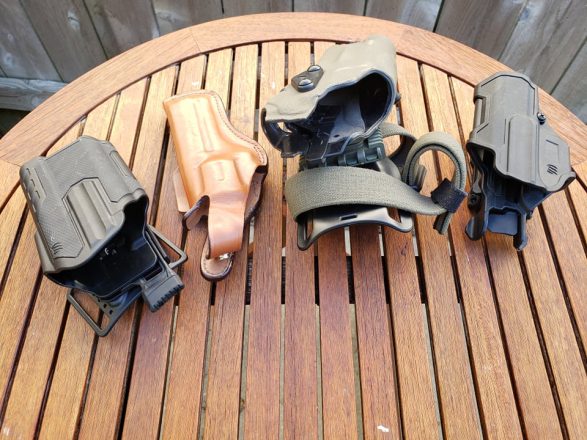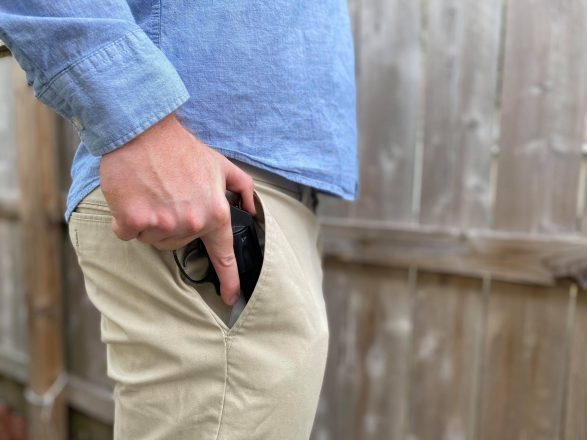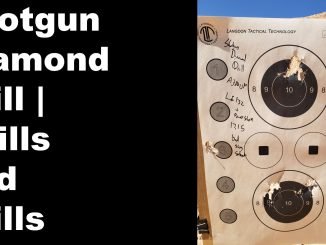
If I could tell you “One Weird Trick” to help you survive your gun fight, would you be interested? What if I said it would cost nothing but a few seconds of your time? No ammo, no tuition fees, no fancy equipment to buy. Sounds like snake oil, right? Luckily, you’re wrong.
Skin that Smoke Wagon
Protecting yourself with a handgun is a multifaceted problem, filled with dozens of techniques to practice. That being said, there are a few things which stand above the rest. The obvious answer is getting rapid and accurate hits on target, which is certainly correct. However, there’s something we must be experts at before getting the chance to send lead down range. Once we’ve made the decision to get our gun out, we must do just that. Get the gun out.
We must draw our pistol quickly and efficiently, that way we can begin aligning our sights and pressing our triggers. This may seem straightforward, but the draw itself is one of the most often flubbed parts of drawstroke for most shooters. Some of you will scoff that, but take a class or attend a match. Watch your fellow shooters. Once pressure is applied and speeds start increasing, people start fumbling for their gun. Problems are magnified when shooting from concealment or with a retention holster. Just a few weeks ago I witnessed a SWAT firearms instructor fumble the draw on his Safariland holster with an SLS hood when trying to go fast during a demonstration. If people have problems in training, then a real life encounter will likely only make things worse. How do we mitigate these problems?
Dry Practice for Your Gun Fight
Dry fire is a common practice among at least mildly serious shooters. We can work nearly every shooting skill without ever firing a live round. However, this still involves a bit of danger. We’re pointing real guns at real things and pressing real triggers. If we practice with our carry guns, this causes us to frequently load and unload live ammunition. In addition to safety concerns, this also causes parts wear and can damage our ammunition. Time is also a factor, as the entire process sucks up half a dozen minutes at a minimum. For those with a busy schedule, there is an easier way.

You’ve gotten ready for your day and have strapped on your gun. What next? Without pulling your gun from the holster, practice the first part of your draw. For conceal carriers, that means clearing your cover garment, and establishing a positive grip on your pistol. If using a duty holster, establish a positive grip, defeat your holster’s retention, and bring your support hand to your chest. Reset your clothing and equipment and get a handful of good reps in before leaving for the day. Guns stay securely in the holster, and we train a challenging skill. The best part is we can get several reps in just a few seconds. Whether you’re prepping for a gun fight or a match, this skill remains the same.
Other Benefits
A common standard for defensive shooting is placing a single round into an 8-inch circle at seven yards in 1.50 seconds. A large portion of that time is the drawstroke. By decreasing the time it takes for us to get our gun out, the more time we have to insure that we’re making a good shot.
Another benefit of this practice is checking the compatibility of today’s outfit with our equipment. Is this shirt longer, which requires a more exaggerated movement to clear concealment? Does this shirt stretch less, needing more force to clear? Are the bungees of our coat getting caught in our holster? Each article of clothing is made slightly differently, and as such, will respond to our movements differently. I know I’ve seen plenty of shooters (myself included) be unknowningly handicapped by their outfit. Those same shooters almost never vet their clothing prior to attempting to draw their firearm. Fractions of seconds could make a difference, and learning how to overcome these obstacles may be the edge you need.
Other Carry Positions
What about those of us who carry in positions other than the waistband? While not as common, a sizeable portion of the population choose to carry in pockets, purses, around their ankles, and more. No matter the location, the idea remains the same. I argue that those carrying in alternative positions need this practice even more, as the drawstroke typically becomes more challenging when moving away from the waistline. These are positions where it is critical that shooters vet their drawstroke before walking out of their home. Again, simply working on accessing the firearm and defeating retention, without drawing, will sharpen your skills and provide insight to the function of the day’s clothing and equipment.

Time yourself for your typical drawstroke as it stands right now. Over the next few days or weeks, work on the techniques you just read above, then time yourself again. You’ll likely find that you’ve shaved a few tenths of a second or more off your par time. Think about how your clothing interacts with this process as well. Do some outfits help or hinder you?
Final Thoughts on Improving Your Chances in a Gun Fight
This is by no means a replacement for full dry practice. We should still train getting a complete presentation, in both live and dry practice. Instead, use this to supplement your normal routine, getting a few more reps in that we normally would not. Put in the work, and I think you’ll find this “One Weird Trick” is more than what you expect.
Support My Work
If you made it this far, thanks for reading! Writing isn’t my full-time profession, and nearly everything I do comes out of my own pocket. Between ammunition, tuition, range fees and more, expenses add up fast. If you like what I have to offer, consider making a donation to my Patreon.
Every bit helps bring more work like this to you, and contributes to shortened timelines or more in-depth work on my part. You’ll also have more direct access to me, offering suggestions for future projects, looking behind the scenes, and getting early access to some content. You can find my Patreon >>HERE<<





Be the first to comment